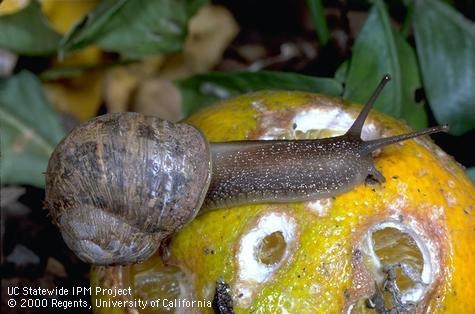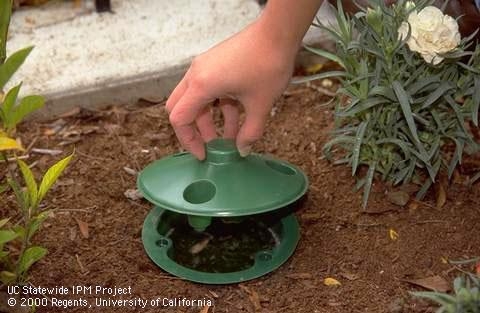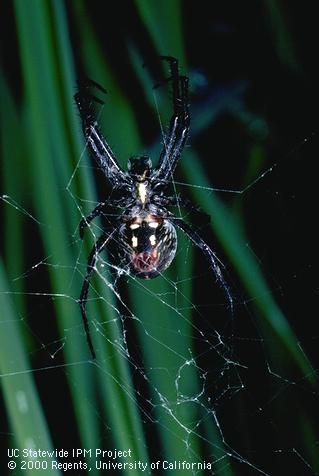UC Blogs
Is Your Hay Biting You?
The straw itch mite (Pyemotes ventricosus) is a predator living in oat hay fields. It is an extremely small mite (1/125 inch long), elongate,...
For the Birds
Doing monthly maintenance at the Children’s Memorial Garden in Fairfield has been more enjoyment than labor. The volunteer Master Gardeners who participate, show up early on the appointed day, with their tools, always eager to begin the task at hand. Everyone finds a job from weeding, deadheading, raking leaves and removing debris. Often we talk and share plant information or discuss upcoming Master Gardener events. Occasionally, in silence, we listen to the hum of bees and observe dragonflies and damselflies as they zoom in and out between the plants. Earlier this year, we observed a crow and heard a meadowlark in the magnolia and arbutus trees behind the little garden.
It was listening to the sounds of the garden that gave me an idea. Why not add a birdhouse on a pole to the garden. It might become a home for the birds and would be a delight to the adults and children who pass by daily. My husband and I had a rustic birdhouse that was embellished with a western motif (metal horse head, stars and horseshoe). The pole we envisioned was something natural, not something perfect or man-made. When we found a seven foot long tree branch in the alley behind our house, it was exactly what we were searching for. After removing most of the branches and cleaning the trunk, the birdhouse was attached to the pole with glue and screws. One weekend we took the birdhouse on the branch to the Children’s Garden and dug a two foot hole to place and stabilize the pole. Not many people notice this addition as it blends into the garden like it has always been there.
As of this writing, there are no new residents in the birdhouse. Maybe the birds are unsure of the horse head significance on their potential nesting home. The birdhouse is standing guard over this tiny garden the Master Gardeners planted in memory of the children of Solano County who have passed away.
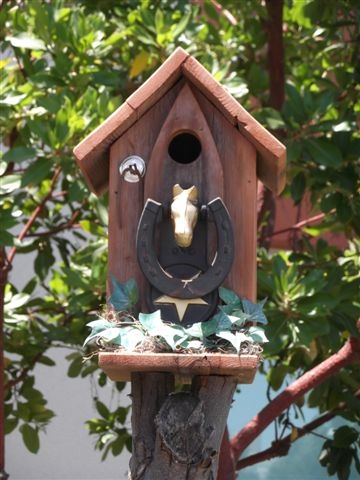
Entrance to the bird house. (photos by Sharon Rico)
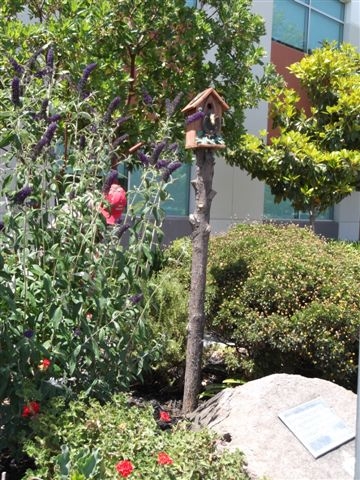
Bird house on a branch (pole).
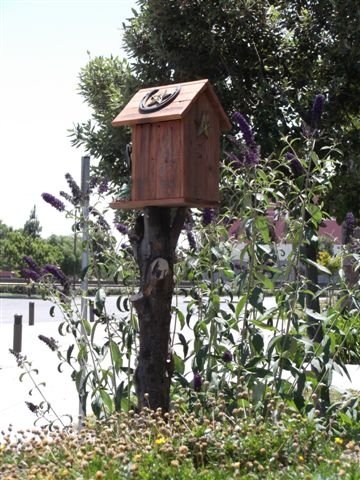
;lk;ljasfd
Let Us Prey
So patient, so passionate. The praying mantis looked hungry last Thursday when it perched on a coneflower in the...
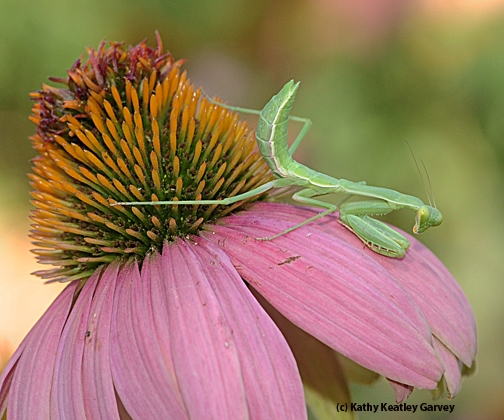
Praying mantis waits and waits. (Photo by Kathy Keatley Garvey)
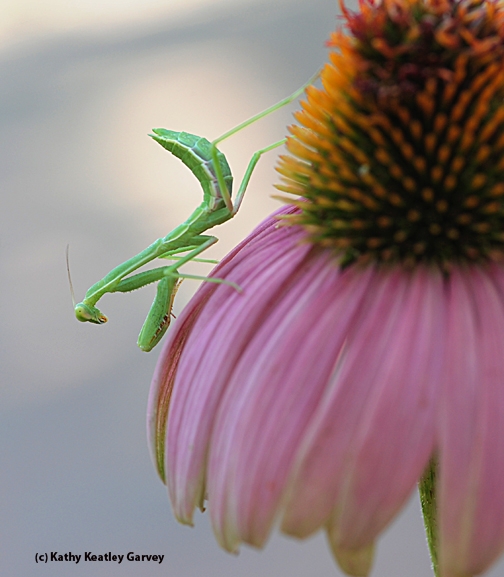
Maybe hunting is better on the other side? (Photo by Kathy Keatley Garvey)
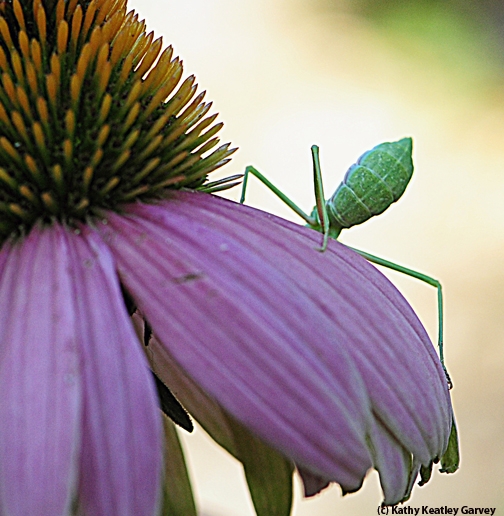
What's on the other side? (Photo by Kathy Keatley Garvey)
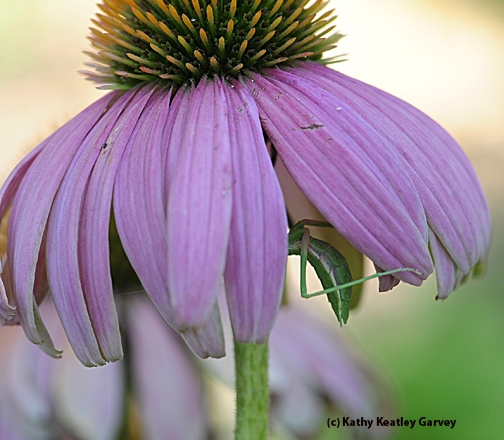
Keeping cool beneath the coneflower. (Photo by Kathy Keatley Garvey)
Hot Blast
Whew. It looks as if we may have survived that eight-day 100-degree-plus “hot spell” around July Fourth. It was brutal, and there was so little — other than watering every morning — that we could do for our plants. The big boys — the trees and larger shrubs — look positively shiny and new now that the Delta breeze has returned and nights and mornings are much cooler. Alas, some of the smaller plants did not fare well. They simply and literally were baked by the heat and sun.
It looks as though we have lost a few daylilies, and they’ve been in the back yard since before we moved here in 2002. Just goes to show you how unusual that long heat wave was. Our tomatoes, peppers and squash are much worse for wear, as well, but seem to be rallying. Needless to say, we have some precooked tomatoes still on the vine, and the bell peppers already have sunburn.
I have to look on the bright side: This baking of our daylilies offers me the chance to plant something new, obviously something more heat-tolerant. Cacti need not apply. Any suggestions?
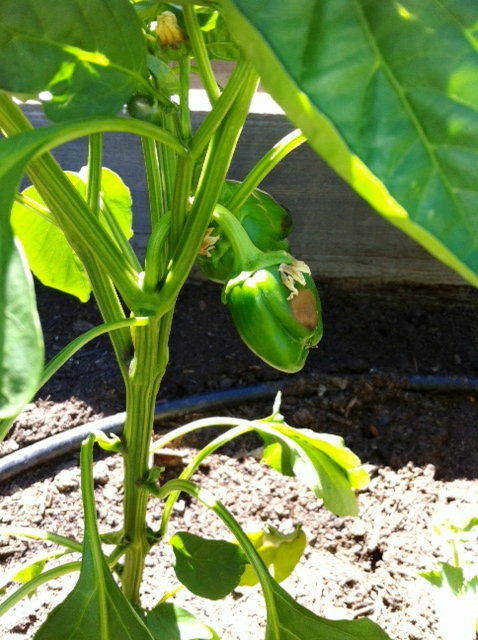
A young bell pepper shows damage from of our recent heat wave. The trellised lemon cucumber, which shades the bells in the afternoons, was decimated by the week of 100-plus-degree days. (photo by Kathy Thomas-Rico)
Snails, slugs and spiders star in new UC IPM videos
Do you have snails and slugs chewing up your favorite garden plants? Are spiders hanging out in and around your home? How can you get rid of those pesky webs?
The UC Statewide IPM program has just released six short videos to help you find answers to these questions. Find the videos on the UC IPM YouTube channel or linked from the specific Pest Notes publications on Snails and Slugs or Spiders.
Snails and slugs chew holes in leaves and fruit of many different types of plants, but they aren’t always present when the damage is discovered. Caterpillars, earwigs, grasshoppers, weevils, and others cause similar damage. How can you identify the culprit? The short video clip “Did a snail eat my plant?” shows damage caused by various pests and can help you identify snail or slug damage by looking for their characteristic slime trails and excrement.
If you do have snails and slugs in the garden and want to control them without using pesticides, learn how to combine trapping with other nonchemical methods for best results in the clip “Trapping snails and slugs.” If you decide to use a pesticide, check out the video on ”How to apply snail and slug bait.” You’ll learn what types of baits are best, which ones to avoid, and how and when to apply them for best results.
Although many people fear them, most spiders you encounter during the day are harmless and can be beneficial in your garden and landscape by eating pest insects. You can see different kinds of spiders in the short clip “Common garden spiders.”
However beneficial they may be, you might not want them inside your home. Even though the easiest method of getting rid of a spider is to kill it, why not trap it and let it loose outdoors to eat those garden pests? “How to catch a spider” shows several ways to easily trap a spider and let it go, including two types of nifty spider catchers that catch spiders in hard-to-reach places. Now what about those sticky webs? “How to clean up spider webs” shows practical methods for removing webs from around your home such as vacuuming, sealing holes in cracks or screens, hosing them off, or using a Webster tool. These methods can also help to keep spiders out of your home.
For more information on snails, slugs, spiders, and other home and garden pests, visit the UC IPM web site.


